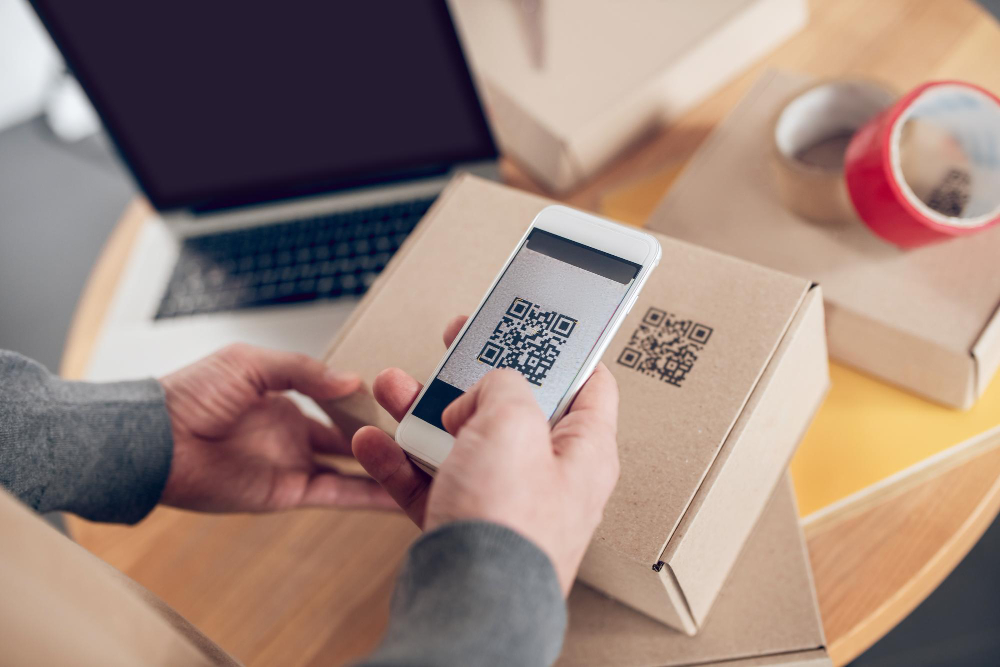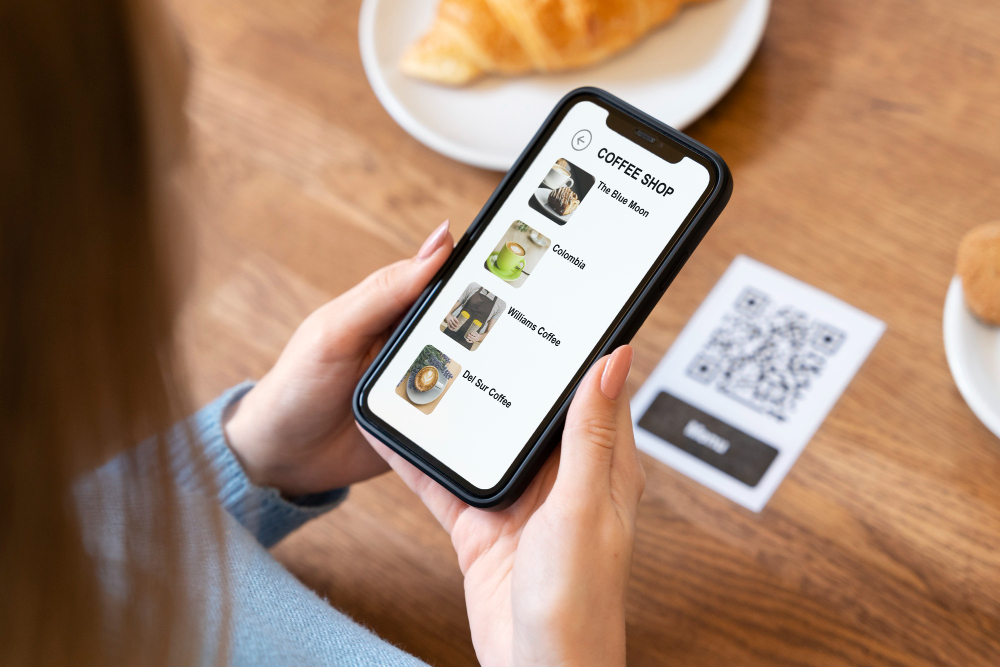What is A Traceability QR Code?
A traceability QR code is a digital tool that allows businesses to track products throughout the supply chain. By scanning the QR code, users can instantly access detailed information about a product’s journey – from raw materials to the finished item on the shelf.
These QR codes serve as a bridge between businesses and consumers, providing transparency and building trust. For food products, traceability QR codes can reveal crucial details such as origin, production date, quality certifications, and handling processes. This helps businesses ensure compliance with regulations, improve supply chain efficiency, and offer consumers peace of mind about the products they purchase.
With the rise of digital solutions, traceability QR codes have become a key part of modern supply chain management, transforming how information is shared and tracked.
How Traceable QR Codes Work?
Traceability QR codes act as powerful tools for ensuring transparency and accountability in the supply chain. They connect physical products to their digital data, allowing businesses and consumers to access detailed product information instantly. Here’s how they work:
- Creation: A QR code is generated and linked to a database containing detailed product information. This could include origin, manufacturing processes, quality checks, and shipping details.
- Placement: The QR code is printed directly onto the product’s packaging, label, or container. In the case of food products, this ensures easy access for both businesses and consumers.
- Scanning: Using a smartphone or scanner, anyone in the supply chain—or the end consumer—can scan the QR code to access real-time information. This process is seamless and requires no special hardware beyond a scanning device.
- Data Sharing: Each scan connects users to a secure digital record. This provides insights into the product’s journey, enabling businesses to track its movement and verify its authenticity.
- Integration: Traceability QR codes work alongside supply chain software to streamline logistics, improve quality control, and ensure compliance with traceability standards.
By simplifying access to information, these QR codes enhance transparency and help businesses deliver high-quality products to consumers.
Why Traceability Matters in Supply Chain Management?
Traceability is essential for maintaining efficiency, transparency, and trust in supply chain management. It allows businesses to track a product’s journey at every stage, ensuring accountability and delivering better outcomes for both companies and consumers. Here are some key reasons why traceability matters:
- Enhanced Product Quality: Traceability ensures that products meet quality standards by tracking their handling, storage, and transportation. For food products, it helps identify contamination risks and maintain freshness.
- Regulatory Compliance: Many industries, especially food and pharmaceuticals, are subject to strict traceability requirements. QR codes make it easier to comply with these regulations by providing instant access to detailed product data.
- Faster Problem Resolution: In cases of recalls or issues, traceability QR codes enable businesses to quickly identify affected batches, minimizing downtime and reducing losses.
- Consumer Trust: Consumers are increasingly demanding transparency about where their products come from and how they are made. Traceability QR codes provide clear, accessible information, helping businesses build stronger customer relationships.
- Data-Driven Insights: With traceability, businesses gain valuable data about their supply chain performance. This information can be used to optimize processes, reduce waste, and make informed decisions.
- Sustainability: Traceability supports ethical and sustainable practices by making it easier to verify sourcing, track environmental impact, and ensure fair labor practices.
By integrating traceability QR codes into their supply chain, businesses can improve operational efficiency, safeguard product integrity, and deliver a better experience to consumers.
Common Challenges in Supply Chain Tracking
Despite its importance, supply chain tracking often faces significant challenges.
- Lack of transparency: Supply chains involve multiple stakeholders, from manufacturers and distributors to retailers and consumers. Without a clear and centralized system for sharing information, it’s difficult to maintain visibility across every step. This lack of transparency can lead to errors, delays, or even loss of trust, especially in industries like food products, where traceability is critical.
- Inefficient Manual Processes: Many businesses still rely on manual methods for tracking products, such as paperwork or spreadsheets. These methods are time-consuming, prone to human error, and inefficient for managing complex supply chains. Inaccurate data or delayed updates can disrupt operations and make it harder to identify or resolve problems.
The Role of Traceable QR Codes in Addressing These Challenges
Traceable QR codes provide an innovative solution to the common challenges faced in supply chain tracking. Here’s how they tackle these issues:
- Enhancing Transparency: By linking each product to a digital record, QR codes make information easily accessible to all stakeholders. Manufacturers, distributors, retailers, and even consumers can scan the code to view real-time updates about the product’s journey. This level of transparency reduces miscommunication and builds trust across the supply chain.
- Automating Processes: QR codes eliminate the need for manual tracking methods by digitizing data collection and sharing. Scanning a QR code automatically updates records, reducing errors and saving time. This automation ensures that supply chain data is accurate, reliable, and always up-to-date.
- Improving Problem Resolution: In case of recalls or disruptions, QR codes allow businesses to quickly trace affected products back to their origin. This speeds up the resolution process and minimizes the impact on operations and customers.
- Boosting Efficiency: With QR codes, stakeholders can instantly access information about sourcing, production, and delivery. This streamlines workflows, enhances decision-making, and improves overall supply chain performance.
By integrating traceable QR codes, businesses can overcome traditional tracking challenges and create a more efficient, transparent, and consumer-friendly supply chain.
Get started with QRStuff
Ready to discover how QR codes can transform your business?
Start by creating your custom QR Code today.
Key Benefits of Using Traceable QR Codes
Improves Transparency and Accountability
QR codes create an open system where product information is easily accessible to all stakeholders. This fosters trust and accountability by ensuring everyone involved, from manufacturers to consumers, can verify a product’s journey, quality, and compliance at any time.
Enhanced Product Safety and Recall Management
Traceable QR codes make it easier to monitor product safety and manage recalls. If an issue arises, businesses can quickly identify affected batches, trace them back to their source, and remove them from circulation, reducing risk to consumers and minimizing damage to the brand.
Streamlined Inventory and Logistics
By providing real-time data about product movement, QR codes help optimize inventory management and logistics. Businesses can track shipments, monitor stock levels, and reduce inefficiencies. This ensures smoother operations and reduces delays in getting products to market.
Cost-Effectiveness and Sustainability
Traceable QR codes eliminate the need for costly manual tracking systems while reducing errors and waste. Additionally, by enabling better resource management and transparency, QR codes support sustainable practices, such as minimizing excess inventory and ensuring ethical sourcing.
Uses Cases for Traceable QR Codes in Different Industries
Food and Beverage
Traceable QR codes have revolutionized how the food and beverage industry maintains transparency and safety. By making critical product information accessible, they bridge the gap between producers, regulators, and consumers:
- Ensuring Food Safety and Compliance
Traceable QR codes help businesses meet stringent safety and regulatory standards by providing real-time access to critical product information. From production dates to quality certifications, stakeholders can verify that food products meet the necessary compliance requirements, reducing risks of contamination or recalls.
- Farm-to-Fork Tracking with Traceable QR Codes
QR codes enable complete transparency by documenting every step of a product’s journey – from the farm where it was sourced to the consumer’s plate. With a simple scan, consumers can learn about the origin, harvesting process, and handling of their food, fostering trust and encouraging informed purchasing decisions.
Pharmaceuticals
In the pharmaceutical sector, traceable QR codes are vital tools for maintaining product integrity and safeguarding public health. Their ability to track and verify each step of a drug’s lifecycle tackles some of the industry’s biggest challenges:
- Fighting Counterfeit Drugs
Counterfeit medications pose significant risks to both patients and the pharmaceutical supply chain. QR codes help combat this issue by allowing each product to be tracked and authenticated. By scanning the code, pharmacies, distributors, and consumers can verify the origin and legitimacy of the medication, reducing the circulation of counterfeit drugs.
- Improving Patient Safety
Traceable QR codes ensure that patients receive accurate information about their medications, including dosage, ingredients, and expiration dates. This transparency minimizes the risk of misuse or adverse reactions. In addition, manufacturers can quickly identify and address issues such as batch defects or recalls, safeguarding patient health.
Manufacturing and Retail
The adoption of traceable QR codes is reshaping manufacturing and retail industries by introducing greater efficiency and transparency at every level:
- Monitoring Production Processes
QR codes enable manufacturers to track each stage of the production process in real time. From sourcing raw materials to assembling finished products, every detail can be documented and accessed with a scan. This level of traceability ensures consistency, improves quality control, and allows for quick identification of issues, reducing downtime and waste.
- Enhancing Customer Trust
In retail, QR codes provide consumers with valuable insights into the products they purchase. Customers can scan a code to verify authenticity, learn about materials or ingredients, and understand the sustainability of the product. This transparency builds trust and fosters loyalty by aligning with modern consumer demands for ethical and informed purchasing.
How to Implement Traceable QR Codes in Your Business?
Choosing the Right QR Code Generator
Selecting a reliable QR code generator is the first step. We recommend using QRStuff, a trusted platform that offers customizable QR codes, dynamic features, and built-in analytics. These tools make it easy to create and manage traceable QR codes, ensuring they work seamlessly across your supply chain.
Best Practices for QR Code on Packaging
Ensure QR codes are placed in visible and easily scannable locations on your product packaging. Use high-contrast designs to make scanning easy and test the codes across different devices to ensure compatibility. Additionally, consider including a short call-to-action near the QR code to encourage users to scan, such as “Scan for product details.”
Integrating Traceable QR Codes with Existing Systems
To get the most out of traceable QR codes, they need to work with your current supply chain and inventory systems. QRStuff makes this easy by offering dynamic QR codes that can be updated with new information without reprinting. For example, if you need to change shipment details or update product specifications, dynamic QR codes let you make those adjustments instantly. Collaborate with your IT team to ensure the QR code data connects smoothly with your existing tools, is securely stored, and is easy for all stakeholders (such as manufacturers, distributors, and retailers) to access when needed.
Ready to Get Started With Traceable QR Codes?
Discover our pricing plans or reach out to us to discover how we can help you build your traceable qr code for better supply chain management.






Hilla Rosenberg,
Content Writer at QRStuff
Hilla is a seasoned content writer at QRStuff, passionate about making tech accessible and engaging. With a knack for breaking down complex topics, she helps businesses and individuals make the most of QR Code technology.